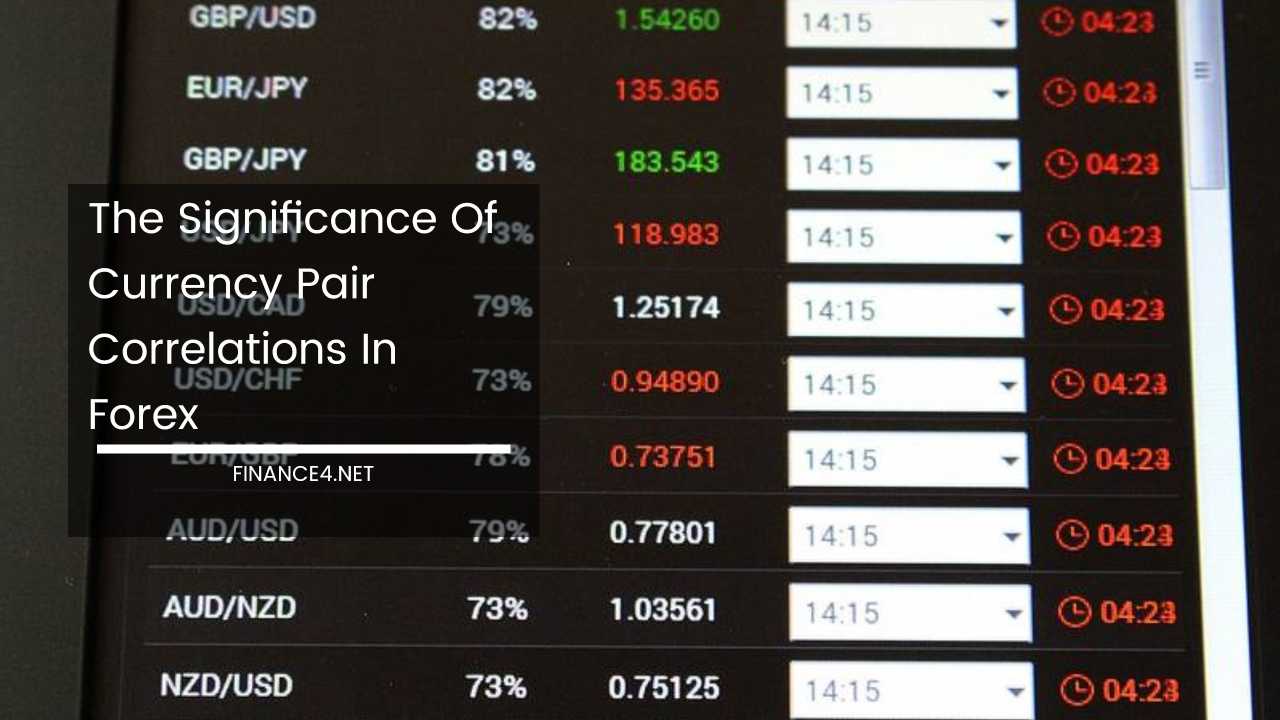Master Forex Trading with Currency Pair Correlations

The Significance Of Currency Pair Correlations In Forex Trading
In the dynamic and often-turbulent waters of foreign exchange (forex) trading, where currencies ebb and flow based on a complex interplay of factors, understanding currency pair correlations is an essential skill for navigating the market with confidence.
This article delves deeper into the significance of currency pair correlations, exploring how they can be harnessed by traders to make informed decisions, mitigate risk, and ultimately achieve success in the forex market.
Demystifying Currency Pair Correlations
Currency pair correlation refers to the statistical measure of how the movements of two currency pairs are linked. It’s expressed as a value ranging from -1 to +1, where:
- +1: A perfect positive correlation, indicating the two currency pairs move in lockstep, with one rising (or falling) as the other does the same.
- -1: A perfect negative correlation, signifying the pairs move in opposite directions. When one currency pair appreciates, the other depreciates by a corresponding amount.
- 0: No correlation, meaning the movements of the currency pairs are independent of each other.
It’s important to understand that correlations are not fixed and can fluctuate over timeframes ranging from short-term (minutes, hours) to long-term (months, years). This dynamism is driven by a multitude of factors, including:
- Economic Data Releases: Economic data releases like GDP figures, inflation reports, and interest rate decisions can significantly impact currency valuations. For example, a strong GDP report for a particular country might strengthen its currency and potentially cause its pairs with other currencies to weaken (negative correlation).
- Interest Rate Differentials: Central banks manipulate interest rates to influence economic activity. Currencies of countries with higher interest rates tend to attract foreign investment, leading to appreciation. This can create positive correlations with currencies of countries having lower interest rates.
- Geopolitical Events: Geopolitical tensions and conflicts can trigger risk aversion in the market, leading investors to seek haven currencies like the US dollar. This can cause positive correlations between safe-haven currencies and negative correlations with riskier currencies.
- Market Sentiment: The overall mood of the market can influence correlations. During periods of optimism, investors might favor riskier assets, leading to negative correlations between safe-haven currencies and higher-risk currencies.
The Power of Correlations for Forex Traders
For forex traders, understanding currency pair correlations unlocks a treasure trove of benefits:
- Diversification and Risk Management: Correlations empower traders to diversify their portfolios effectively. By strategically selecting currency pairs with low or negative correlations, traders can spread their risk. This means that if one position suffers losses due to a market downturn, another negatively correlated position might experience gains, potentially offsetting those losses and providing a buffer against excessive volatility.
Beyond the Basics: Advanced Techniques for Utilizing Correlations
While diversification is a core benefit, advanced traders can leverage correlations for even more sophisticated strategies:
-
Hedging with Options: Traders can utilize currency options to hedge their exposure while still profiting from potential price movements in the underlying currency pair. By understanding correlations, traders can identify suitable option contracts for hedging specific positions, further mitigating risk.
-
Correlation Trading: This involves exploiting short-term deviations from established correlations between currency pairs. When a normally highly correlated pair experiences a temporary divergence, traders can capitalize by taking advantage of the imbalance and profiting from the eventual correction that brings the pair back into alignment. However, correlation trading requires precise timing and a deep understanding of market dynamics.
-
Statistical Arbitrage: This advanced strategy utilizes correlations to exploit tiny price discrepancies between correlated assets. By simultaneously buying and selling assets with a known historical correlation, traders can potentially profit from minute inefficiencies in the market. However, statistical arbitrage requires sophisticated algorithms and significant capital, making it suitable only for experienced traders with access to advanced trading tools.
-
Enhanced Trading Strategies: Correlations provide valuable insights for crafting effective trading strategies. Positive correlations can be exploited through strategies like hedging or basket trading, as discussed earlier. Conversely, negative correlations can be utilized for pairs trading.
-
Risk Assessment: Analyzing correlations is crucial for assessing overall portfolio risk. Positions in highly correlated assets expose the portfolio to greater vulnerability if the market moves against those assets. By monitoring correlations, traders can identify and adjust their exposure to minimize risk from unexpected market swings.
-
Market Sentiment Analysis: Correlations can also act as barometers of broader market sentiment. For instance, during periods of risk aversion, positive correlations emerge between safe-haven currencies as investors flock to them. Conversely, negative correlations arise between safe-haven currencies and riskier currencies as investors shy away from the latter. By analyzing these correlations, traders can gain valuable insights into the collective mindset of the market.
-
Forecasting Trends: Examining historical correlations can aid traders in potentially forecasting future trends. If a strong correlation persists over extended periods, it might indicate a deeper underlying relationship between the currency pairs, potentially linked to factors like trade dependency or economic ties between the issuing countries. This can provide clues about potential trading opportunities based on the continuation of this established correlation. However, it’s vital to remember that correlations are not guarantees of future price movements, and unforeseen events can disrupt them.
Navigating the Challenges of Currency Pair Correlations
While currency pair correlations offer a valuable tool for forex traders, there are challenges and considerations to keep in mind:
- Dynamic Nature: Correlations are not static. They can evolve rapidly in response to ever-changing market dynamics. Economic events, geopolitical tensions, and central bank policies can all influence correlations, necessitating constant monitoring and adaptation of trading strategies. Traders should employ a combination of correlation analysis with other technical and fundamental analysis tools to form a well-rounded trading strategy.
- False Correlations: Traders should exercise caution against relying solely on correlations without factoring in other fundamental and technical analysis tools. Spurious correlations, which arise by chance due to coincidental movements in unrelated events, can lead to misguided trading decisions. For instance, a temporary economic slowdown in two countries might cause their currencies to weaken simultaneously, creating a misleading negative correlation. Verifying correlations over extended periods and through various economic indicators helps mitigate the risk of acting on false correlations.
- Limited Predictive Power: Correlations, while insightful, do not guarantee future price movements. Market conditions are inherently unpredictable, and correlations may break down unexpectedly. For example, a political upheaval in one country could cause its currency to weaken despite a historically strong positive correlation with another currency. Traders should supplement correlation analysis with robust risk management practices and thorough research before entering any trade.
Beyond Correlation: Additional Factors for Forex Success
While currency pair correlations are a powerful tool, forex success hinges on a broader understanding of the market:
- Fundamental Analysis: This involves studying economic data, central bank policies, geopolitical events, and other factors that influence currency valuations. A strong grasp of these fundamentals allows traders to make informed decisions about the intrinsic value of a currency and its long-term trajectory.
- Technical Analysis: This focuses on analyzing historical price charts and technical indicators to identify potential entry and exit points for trades. By understanding technical analysis tools like support and resistance levels, moving averages, and relative strength index (RSI), traders can make informed decisions based on short-term price movements.
- Risk Management: Effective risk management is paramount in forex trading. Implementing strategies like stop-loss orders and proper position sizing helps limit potential losses and safeguard capital.
Final Thoughts
In the intricate landscape of forex trading, currency pair correlations play a pivotal role in guiding trading decisions, managing risk, and ultimately achieving success.
By understanding the relationships between currency pairs, employing a variety of analytical tools, and implementing sound risk management practices, traders can navigate the dynamic forex market with greater confidence and make informed decisions to achieve their trading goals.



